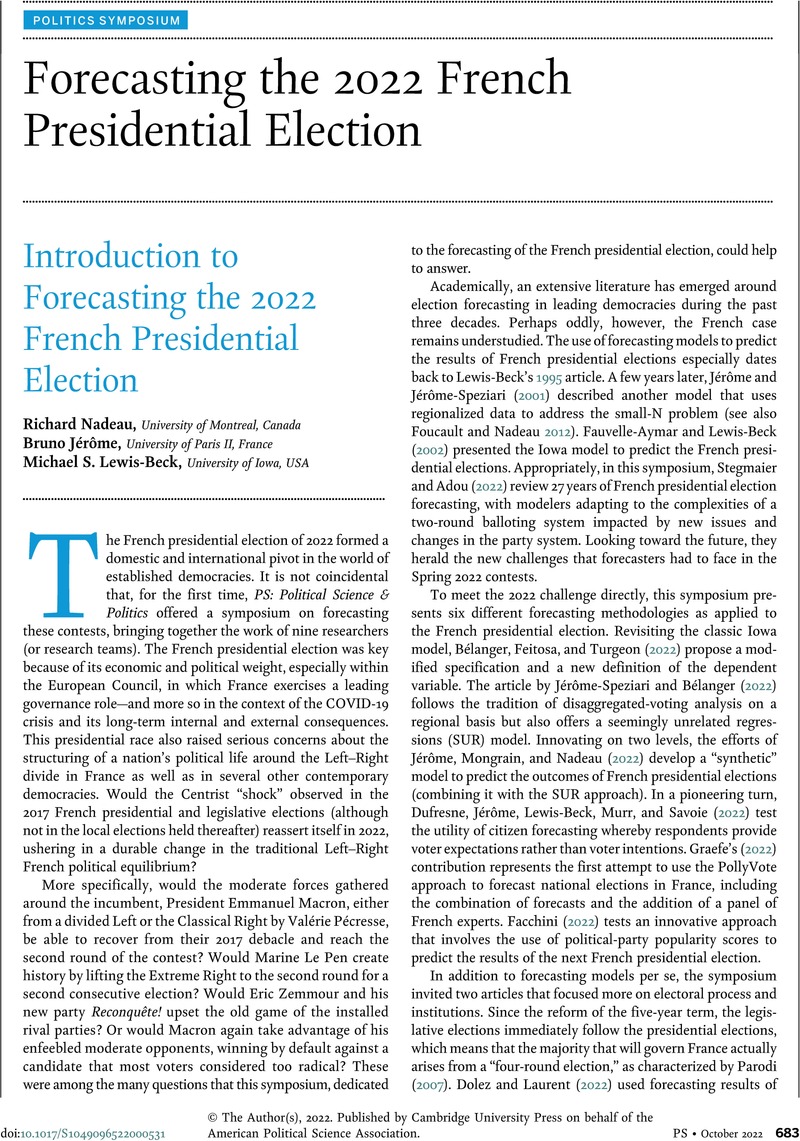No CrossRef data available.
Article contents
Introduction to Forecasting the 2022 French Presidential Election
Published online by Cambridge University Press: 23 March 2022
Abstract
An abstract is not available for this content so a preview has been provided. Please use the Get access link above for information on how to access this content.

- Type
- Forecasting the 2022 French Presidential Election
- Information
- Copyright
- © The Author(s), 2022. Published by Cambridge University Press on behalf of the American Political Science Association
References
REFERENCES
Bélanger, Éric, Feitosa, Fernando, and Turgeon, Mathieu. 2022. “Which Historical Forecast Model Performs Best? An Analysis of 1965–2017 French Presidential Elections.” PS: Political Science & Politics. DOI: 10.1017/S1049096522000439.Google Scholar
Berg, Joyce, Gruca, Thomas S., and Rietz, Thomas A.. 2022. “Designing Prediction Markets to Forecast Multi-Stage Elections: The 2022 French Presidential Election.” PS: Political Science & Politics. DOI: 10.1017/S104909652200052X.Google Scholar
Dolez, Bernard, and Laurent, Annie. 2022. “A Legislative Majority for the Future President? Revisiting the Phenomenon of ‘Honeymoon’ Elections Under the Fifth Republic.” PS: Political Science & Politics. DOI: 10.1017/S1049096522000506.Google Scholar
Dufresne, Yannick, Jérôme, Bruno, Lewis-Beck, Michael S., Murr, Andreas, and Savoie, Justin. 2022. “Citizen Forecasting: The 2022 French Presidential Election.” PS: Political Science & Politics. DOI: 10.1017/S1049096522000567.Google Scholar
Facchini, François. 2022. “Party Ratings and Electoral Forecasting: The Case of the French Presidential Election in 2022.” PS: Political Science & Politics. DOI: 10.1017/S1049096522000440.Google Scholar
Fauvelle-Aymar, Christine, and Lewis-Beck, Michael S.. 2002. “Pour l’Iowa, Avantage Jospin.” Libération, March 21.Google Scholar
Foucault, Martial, and Nadeau, Richard. 2012. “Forecasting the 2012 French Presidential Election.” PS: Political Science & Politics 45 (2): 218–22.Google Scholar
Graefe, Andreas. 2022. “Combining Forecasts for the 2022 French Presidential Election: The PollyVote.” PS: Political Science & Politics. DOI: 10.1017/S1049096522000555.Google Scholar
Jérôme, Bruno, and Jérôme-Speziari, Véronique. 2001. “Ils ont Trouvé la Formule Qui Donne Le Résultat Des Élections.” L’Expansion, November 8.Google Scholar
Jérôme, Bruno, Mongrain, Philippe, and Nadeau, Richard. 2022. “Forecasting the 2022 French Presidential Election: From a Left–Right Logic to the Quadripolarization of Politics.” PS: Political Science & Politics. DOI: 10.1017/S1049096522000488.Google Scholar
Jérôme-Speziari, Véronique, and Bélanger, Eric. 2022. “Forecasting the 2022 French Presidential Election with a SUR Regionalized Model.” PS: Political Science & Politics. DOI: 10.1017/S1049096522000518.Google Scholar
Lewis-Beck, Michael S. 1995. “Comparaison de Prévision des Élections Présidentielles en France et aux États-Unis.” Journal de la Société Française de Statistique 136 (1): 29–45.Google Scholar
Parodi, Jean-Luc. 2007. “L’ancrage d’une curiosité française: l’Élection ‘exécutive’ à quatre tours.” Revue Française de Science Politique 57 (3–4): 285–91.CrossRefGoogle Scholar
Stegmaier, Mary, and Adou, Kouakou D.. 2022. “Predicting French Presidential Elections: A Challenge for Forecasters.” PS: Political Science & Politics. DOI: 10.1017/S104909652200049X.Google Scholar


